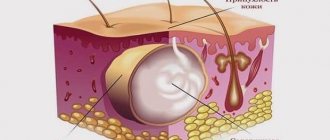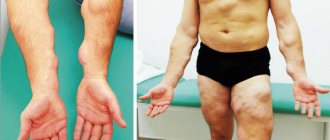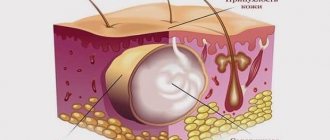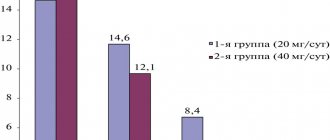Pathology is included in the list of neoplasms that arise in the area of the pilosebaceous apparatus of the dermis. Atheroma is a capsule filled with a thick whitish-yellowish secretion with an unpleasant odor. The outer shell of the tumor-like formation is formed from connective tissues covered with flat epithelial cells in several rows.
Atheroma is
A neoplasm on the skin of cystic origin, which is a consequence of blockage of the sebaceous gland duct. The cyst appears in those areas of the body where hair grows: head, face, neck, back, genital area. Usually people are very worried about atheroma on the neck, the removal of which is necessary in the same way as if they are localized in other places.
What does atheroma look like (photo)
The neoplasm has clear contours, is mobile, and looks like a dense ball with lard-like contents. In the center of the cyst, you can notice a tense, swollen point, which is a blocked outlet of the sebaceous duct.
As for pain, only during suppuration the patient will feel pain; otherwise, there is no such factor. In addition, in case of suppuration, swelling, redness, and fever occur. It is worth considering that sometimes atheroma breaks out on its own, releasing pus along with the contents of the sebaceous glands.
If you need to undergo surgery to remove atheroma in Moscow, the Yuzhny clinic is the right option to go to for quality medical care.
Reasons for education
A cyst can appear for various reasons, including:
- disruption of the functioning of the sebaceous glands, manifested by insufficient exfoliation of the skin, hyperhidrosis, seborrhea or persistent keratinized cells, as well as high viscosity of sebum;
- problems with the endocrine system;
- negative environmental impact (for example, working in conditions of constant pollution with various irritants);
- difficulties with the urinary system;
- failure to comply with hygiene rules;
- low-quality cosmetics that narrow the ducts of the sebaceous glands (in particular, deodorants and antiperspirants), various cosmetic procedures (hair removal and depilation);
- inflammatory processes on the skin, as well as;
- damage to hair follicles.
The consequence of the above factors can be not only atheroma, but also other skin ailments.
Prevention
There are no effective methods of prevention. If there is increased secretion of the sebaceous glands, atheromas may appear in places near removed bumps or in new locations. As a preventative measure, you can eat less fatty and high-carbohydrate foods so as not to stimulate the glandular apparatus. Use antiperspirants as little as possible; your skin is oily. Use the right skincare products for your skin type to ensure that your pores are free of sebum.
Symptoms
The cyst manifests itself as follows:
- the appearance of a dense formation, similar to a ball, which is filled with light (white or pale yellow) contents;
- the neoplasm has clear boundaries that can move if you press on the ball;
- sometimes the duct of the sebaceous gland is noticeable;
- absence of pain (exception - suppuration, permanent damage to the cyst, rubbing).
Sometimes it happens that there are several atheromas on the patient’s body. At the same time, they can be either grouped or separate. They have a wide variety of sizes - from 5 millimeters to 4 centimeters.
It is worth noting that there are three options for the development of atheroma:
- Opening it up and turning it into an ulcer.
- Overgrowth of the cyst with thick connective tissue. The neoplasm does not change throughout the patient's life.
- Transition from a benign state to a malignant one (development of skin cancer).
The last option is the most unfavorable, and therefore you should promptly seek help in removing atheroma.
Diagnostics
To diagnose atheroma, in most cases, an initial examination by our specialists using palpation is sufficient, which reveals the presence of an elastic neoplasm similar to a ball. Of course, when making a diagnosis, the patient’s complaints, as well as the medical history, are taken into account.
If there are concomitant skin diseases or there is a suspicion of another disease (lipoma, osteoma or fibroma), differential diagnosis is carried out, which requires the following examinations:
- Ultrasound;
- diagnostic puncture;
- general blood test and for the presence of infectious diseases;
- coagulogram, which allows you to evaluate blood clotting.
The above procedures not only help diagnose the disease in case of doubt, but also identify contraindications, understand the patient's health status, which will ultimately prevent the formation of complications.
Methods for removing atheroma
The following methods are used in medicine:
- surgical intervention;
- laser therapy;
- radio wave method.
For this purpose, the most modern techniques are used, guaranteeing an excellent cosmetic effect, reducing the risk of complications and recurrence of the disease to a minimum.
The choice of therapy depends on complications and the size of the cyst. So, if it is not complicated and surgical intervention is chosen, then the doctor cuts the skin and completely removes the atheroma along with the contents and capsule. The procedure is performed under local anesthesia; the puncture minimizes the risk of scar formation after surgery. If the cyst is complicated by suppuration or inflammation, then surgical intervention is carried out in two stages:
- The surgeon opens the abscess and removes the contained mass.
- The doctor eliminates the tumor capsule, which minimizes the risk of re-infection.
As for laser removal of atheroma, it has the advantage of being minimally invasive. This is a modern method, which is carried out only in cases where the cyst is small and always under local anesthetic. After such manipulation, the wound heals faster, there are no stitches, and scars, as a rule, do not appear. In addition, the procedure takes a minimum amount of time.
The last of the methods presented involves the impact of radio waves on the affected areas without affecting healthy tissue. The most important advantage of the manipulation is the shortest recovery period (2-3 days). Also, there are no scars left after the procedure.
If the situation is very advanced (severe inflammation, abscess or infection), then an emergency surgical operation is performed to remove the atheroma, in which the tumor is not removed, but only cleaned. The elimination procedure is carried out only after healing, the period of which is on average 3 months. After the procedure, the patient may be prescribed antibiotics (depending on his initial condition).
Surgical
Surgery is performed if the cyst is large or there is inflammation.
Before the operation, local anesthesia is administered, after which the doctor makes an incision in the membrane of the cyst. If the atheroma has a hole, two such punctures will be needed. After this, the surgeon cleans the capsule cavity. If there is pus, then cleaning is carried out with special care - the walls of the cyst must not be allowed to rupture. After the manipulations, the capsule is completely cut.
After the procedure, the doctor stitches and treats the wound. In case of surgical removal of atheroma, suture removal must be ensured on the 7th day after surgery.
The recovery period after manipulation is from 8 to 10 days, during which it is necessary to wear a sterile dressing to prevent infection of the wound, for which it is necessary to treat the postoperative area with disinfectants for 2-3 days. Antibacterial treatment may also be needed.
It should be borne in mind that in case of severe inflammation, abscess or infection, emergency surgery is performed, during which only cleaning is performed. The healing period in this case increases to 3 months, after which time a planned operation is performed according to the above algorithm.
Radio wave
The radio wave method is one of the most popular because it provides an excellent cosmetic effect without leaving scars. For this manipulation, a special radio wave scalpel is used, which affects the tissue with high-frequency current. It is needed in order to simultaneously cut the tissue and carry out coagulation.
Among the main advantages of radio wave removal of atheroma:
- the risk of recurrence of the disease is minimized;
- short recovery period (2-3 days);
- once the procedure is completed, the patient can return to their normal lifestyle;
- excellent cosmetic effect;
- the scalpel does not touch healthy tissue;
- no bleeding due to coagulation.
As for the duration, it averages 20-30 minutes. At the end of the procedure, a small soft tissue defect remains.
The operation is carried out as follows: first, local anesthesia is given, after which the doctor burns out the atheroma from the inside with an instrument.
Laser removal of atheroma
Laser tumor correction is used when the cyst is small in size. This procedure uses a CO2 laser to vaporize the cyst using high temperature without affecting adjacent tissue. As in the case of the radio wave method and surgery, local anesthesia is used.
Among the advantages of eliminating atheroma using a laser are:
- the instrument does not touch adjacent healthy tissue;
- thanks to the coagulating effect, the operation takes place with minimal bleeding;
- the method is non-contact, which prevents infection;
- the risk of relapse is minimized;
- There are no scars left at the site where the atheroma was removed with a laser.
The duration of the operation, as a rule, does not exceed 30 minutes.
Prices
| Service | price, rub. |
| Consultation with a surgeon, candidate of medical sciences | 1800,00 |
| Consultation with a surgeon, candidate of medical sciences (branch on Krasnaya Presnya) | 2600,00 |
| Consultation with a surgeon | 1600,00 |
| Repeated consultation | 1300,00 |
| Surgical removal of atheroma (1 formation) | 7000,00 |
| Treatment of corns using radiosurgical method | 3700,00 |
| Dressing | 500,00 |
Sources
- Kisilev V. A., Murzagareeva M. N., Vasilyeva N. A. Experience in surgical treatment of atheromas. Consultative and diagnostic clinic of the Federal State Institution “1477 Naval Clinical Hospital” of the Ministry of Defense of the Russian Federation. Vladivostok. year 2014.
- Grigorieva T. S. Results of surgical treatment of facial atheroma using a gentle method (cystotomy). Crimean State Medical University named after. S.I. Georgievsky. Simferopol.
- Skin atheroma. Wikipedia
How to prepare for surgery to remove atheroma?
As a rule, the procedure to eliminate a tumor is carried out as planned, and only in special cases when the patient has a strong inflammatory process and suppuration - in an emergency. Before carrying out the manipulation, it is necessary to conduct examinations that will help detect possible contraindications:
- general blood analysis;
- study of blood glucose levels and the presence of infections;
- coagulogram.
All these examinations prevent the occurrence of complications, and it is necessary to approach them especially carefully if an operation is planned to remove atheroma in a child.
How is the operation performed?
It is carried out as follows:
- Local anesthesia is administered.
- An incision is made on the surface of the atheroma (if there is a hole, then two).
- The cavity of the capsule is cleaned (in the case of suppuration, the surgeon must clean it more thoroughly).
- The capsule is excised.
- Stitches are applied along with wound treatment.
The suture after removing the atheroma must be removed after 7 days, for which you need to visit a specialist. Within 2-3 days it is necessary to treat the postoperative area with disinfectants. The doctor may also prescribe antibiotics.
On the ears
The procedure for removing atheroma on the ears is carried out in a medical clinic. Self-medication is strictly prohibited as it can cause complications. 3 methods are used: surgery, laser therapy and radio wave method. The most effective method for surgical removal of this type of atheroma is surgery to clean and remove the cyst. If the size of the tumor is small, laser therapy is used. All manipulations are performed under local anesthesia. For the operation, you need to go to the hospital, but for the radio wave and laser methods you don’t need to do this - sometimes, if you have the necessary tests on hand, they can be done right on the day of treatment.
In some particularly advanced cases (if the cyst becomes inflamed or suppuration occurs), you must first visit an otolaryngologist to prevent inflammation of the adjacent tissues. Removal of ear atheroma occurs as follows: the doctor opens the tumor along with its contents, after which he prescribes a course of antibiotics. Only after this can surgery be performed to remove the tumor. If the patient decides not to have surgery, the cyst will most likely reappear.
On the head
In most cases, when a cyst forms on the head, we can talk about multiple atheromas (70%). After the necessary examinations to remove the tumors, the doctor may prescribe surgery, laser therapy or surgery using a radio wave scalpel. All these methods have already proven to be effective and disease-free, and are performed under local anesthesia.
As a rule, surgical intervention is used to eliminate atheromas on the head. Despite its effectiveness, it has the longest healing period compared to other methods. After the operation, a histological examination is performed to identify the type of tumor. This procedure is not performed after the laser and radio wave method, however, atheroma of the head after removal using the above methods has a low chance of relapse.
On the face
Atheromas can also form on the face - and, as a rule, these are small cysts, since if the tumor covers the face, patients seek help faster for the sake of a cosmetic effect. For this reason, in most cases, laser correction and radio wave treatment are performed to remove atheromas on the face. They help avoid recurrence of infection, are painless, and do not leave scars. In medicine, such manipulations are carried out by highly qualified specialists with sufficient experience.
On the back
Compared to other areas where atheromas appear, here they form in 45% of cases. The reason is a large accumulation of sebaceous glands and possible problems with thermoregulation.
If the cyst is small, then it may not cause any discomfort, and in this case, specialists resort to eliminating it using a laser or radio wave scalpel. If the tumor has grown to a large size, only surgery will help. It is better not to reach this state by contacting a doctor in a timely manner to remove atheroma on the back.
On the foot
As for the cyst on the leg, this location is the least common. Laser correction or radio wave method is used if the tumors are small, and surgical intervention if the atheroma has grown. You should not delay seeking medical help if atheroma appears on your leg.
Classification
The cellular structure of atheromas is different. Since this does not manifest itself clinically, the histological classification is practically not used and is of interest only to researchers. The more common classification is based on the mechanism of formation of sebaceous gland cysts:
- True or primary. These are congenital formations that are formed at the stage of intrauterine development of the fetus. It is usually diagnosed in children from the moment of birth. Often the formations are multiple in nature and rarely exceed 5 mm in diameter. Mostly located in the perineal area.
- False or secondary. They occur mainly in adults as a result of blockage of the duct of unchanged sebaceous glands. Over time, the cyst gradually increases and can reach 10 cm in diameter. Localization of false atheromas is most often observed on the head, neck and upper back.
Rehabilitation
The rehabilitation period depends on the type of procedure. So, the longest recovery period is after surgery (8-10 days). If the operation had to be done urgently, only to clear the atheroma for subsequent surgical intervention, then the healing period is about 3 months - only after this period can you consult a doctor again for surgery.
The patient needs to treat the wound after removal of the atheroma for 2-3 days, and after 7 days come to remove the sutures. The doctor may also prescribe antibiotics (depending on the severity of the situation).
After laser treatment and radio wave treatment, antibiotic treatment is usually not required, since these instruments disinfect the affected area. The recovery period in both cases is 2-3 days, and another advantage is that there are no scars left after them.
Postoperative period
In the first days after removal of the capsule, it is important to carefully monitor the condition of the wound. At first, the surgeon performs daily procedures, changing the drainage device and antiseptic dressings. The total duration of the postoperative period is 10-14 days. It takes place on an outpatient basis. Occasionally, complicated forms of atheroma are treated in a surgical hospital.
After the formation of connective tissue between the edges of the wound, the sutures are removed. This manipulation takes no more than 3-5 minutes and is usually painless.
Possible complications
The most common complication of a neoplasm is suppuration of the cyst, which indicates the addition of a bacterial infection. After this, the following symptoms appear:
- secondary inflammatory process;
- development of suppuration on the skin and subcutaneous tissue;
- spontaneous opening of the cyst or self-removal, after which it forms again;
- scars appearing after unauthorized removal of the tumor.
It is extremely rare that a benign neoplasm is modified into a malignant one. It is worth noting that retention cysts never develop into this state.
If the atheroma is not treated, its surface can break through on its own, releasing thick pus with a sebaceous mass. Further, if the infection spreads to adjacent tissues, phlegmon may develop - purulent inflammation without clear boundaries. This situation is considered dangerous, and an emergency operation is performed in which the cyst is only cleaned.
If you need to undergo surgery to remove atheroma, Moscow is your region - do not delay your visit to the doctor until possible complications arise. Removing a clogged sebaceous gland at an early stage is guaranteed to produce results, preventing the deterioration of the patient’s health condition, the occurrence of relapses, and, above all, an excellent visual effect is noticeable. This is all thanks to the highly qualified specialists who work in the medical field.
Description of the disease
Atheroma is one of the relatively harmless tumors due to the fact that it does not transform into a malignant neoplasm.
However, there is a risk of significant increase in size, so medical attention is required in all cases. Teenage children are more likely to experience this problem. Boys and girls get sick about the same. The main reason why parents first turn to a surgeon is the presence of a visually noticeable tumor.
The atheroma itself is a small capsule filled with pasty contents. It is sebum, which, due to blockage of one or more glands, did not come out, but remained in the subcutaneous tissue.
Frequently asked questions about atheroma removal
Below are the most popular questions from clients of the Yuzhny clinic in Moscow. The answers were provided by our highly qualified specialists.
After removal of atheroma, the suture hurts and oozes, is this normal?
There should be no pain after removal of the atheroma, so you must urgently contact the doctor who performed the operation. There may be concomitant diseases.
Can there be a relapse?
Relapse is possible after poor removal of the cyst.
Is it possible to remove atheroma at home yourself?
This is strictly prohibited, as it can cause unwanted complications such as severe inflammation and an abscess. Ultimately, you will have to undergo emergency surgery.
Which method is the most effective?
Laser treatment and the radio wave method show good effectiveness, but are used in cases where the tumors are small. If the atheroma has reached a large size, only surgery is used. Regarding the issue of cost, the price for the radio wave method and laser removal of atheroma is correspondingly higher compared to surgical intervention.
Advantages of visiting our clinic
If you need removal of atheroma using the radio wave method in a clinic in St. Petersburg, then you can safely contact us. Our clinic employs highly qualified specialists with extensive experience who can competently diagnose and prescribe effective treatment. During their work, our ENT doctors use the most modern equipment to treat atheroma. We try to find an individual approach to each patient in order to take into account the characteristics of his body as much as possible. Our center employs highly qualified surgeons who can successfully remove atheromas without the risk of relapse. So, by contacting us, you can enjoy the following benefits:
- Consultation with a doctor with extensive experience.
- Competent diagnostics.
- Correct prescription of treatment.
- Treatment of atheroma is carried out using the most advanced technologies and modern equipment.
- Individual approach to each client and polite treatment.
- Favorable prices.
In addition, our center also employs pediatric ENT doctors , during whose appointments your children will not be afraid. You can find out more detailed information about how atheroma is removed using the radio wave method, prices and much more by contacting our employees by phone.








